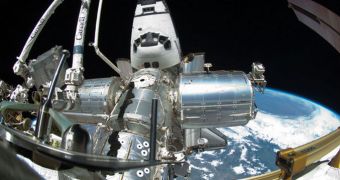Yesterday night (May 29), the STS-134 crew aboard space shuttle Endeavour tried out a new docking system that relies on lasers to guide incoming spacecraft to the International Space Station (ISS).
In order to do that, the orbiter had to undock from the facility late on Sunday, and then try to dock again using the laser-based guidance system, called the Sensor Test of Orion Rel-nav Risk Mitigation.
The STORRM system was already mounted on Endeavour's Orbiter Docking System (ODS), and the astronauts making up the spacecraft's crew simply separated from the station, and then flew for a bit around the massive structure.
They then tried for a new docking procedure on the Pressurized Mating Adapter (PMA-2), which is currently mounted on the forward port of the Harmony module. After the tests were carried out, the shuttle did not dock to the station again, but backed off and remained at a safe distance.
According to Space, the first separation between the two occurred at 11:55 pm EDT (0355 May 30 GMT), after Endeavour had spent nearly 14 days docked to the ISS. The orbiter is scheduled to have a total run in space of about 16 days.
At this point, the mission timer shows more than 13 days spent in orbit. The shuttle is scheduled to return to the Kennedy Space Center (KSC), in Florida, on Wednesday, June 1. After that time, it will be retired, decommissioned, and set on permanent display in a museum.
The entire purpose of the STORRM system is to make it easier for future spacecraft – such as the newly announced Multi-Purpose Crew Vehicle (MPCV) – to find their way to the appropriate docking ports on the station.
These sensors contain new docking camera and navigation systems, NASA officials say. Advanced laser-based sensor technology and high-definition imagery are used to give the sensor its abilities.
“Rendezvous and docking – whether we do it in low-Earth orbit or out in exo-LEO, which is lunar or Mars – will require some kind of rendezvous and docking, whether robotic or with crewed missions,” explained researcher Howard Hu.
“That component requires a good navigation sensor, and that is what STORRM is all about. We're testing a navigation sensor capability,” he told reporters during a press conference on Friday (May 27).
The expert holds an appointment as a system performance and analysis manager at the NASA Johnson Space Center (JSC) in Houston, Texas.
“The best way to reduce risk is to test in the space environment, and test in a relevant environment, and the best relevant environment we have is the International Space Station. And, of course, the space shuttle is a great test bed for us,” he concluded.

 14 DAY TRIAL //
14 DAY TRIAL //